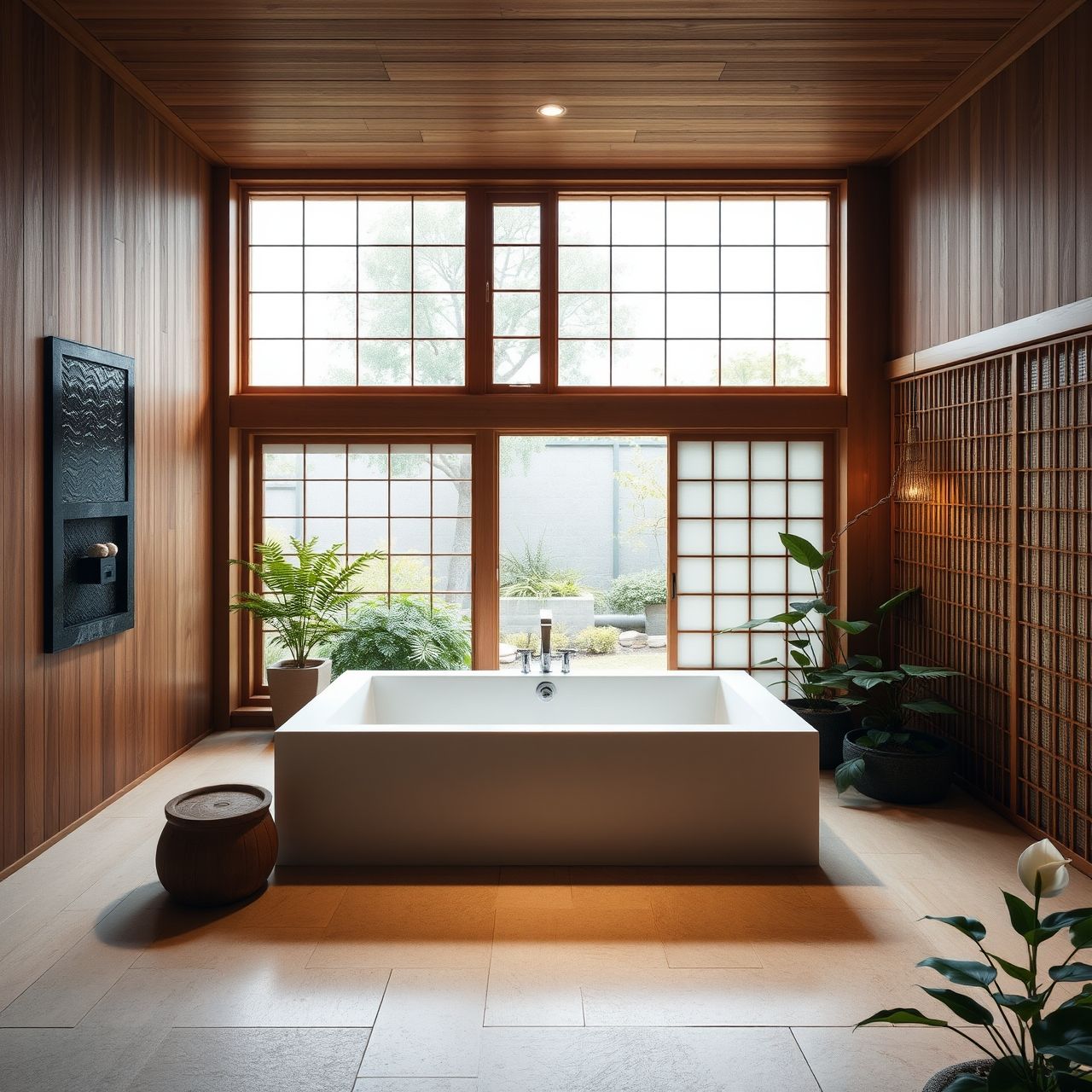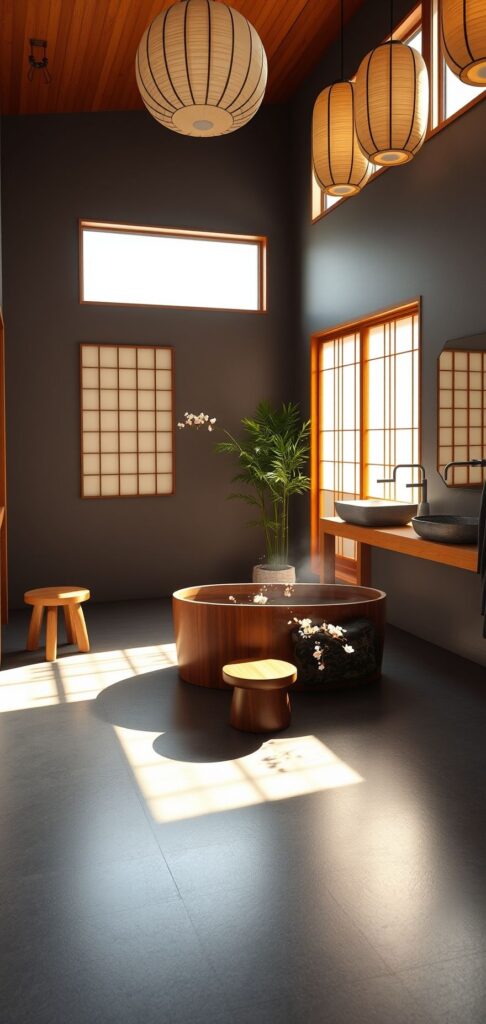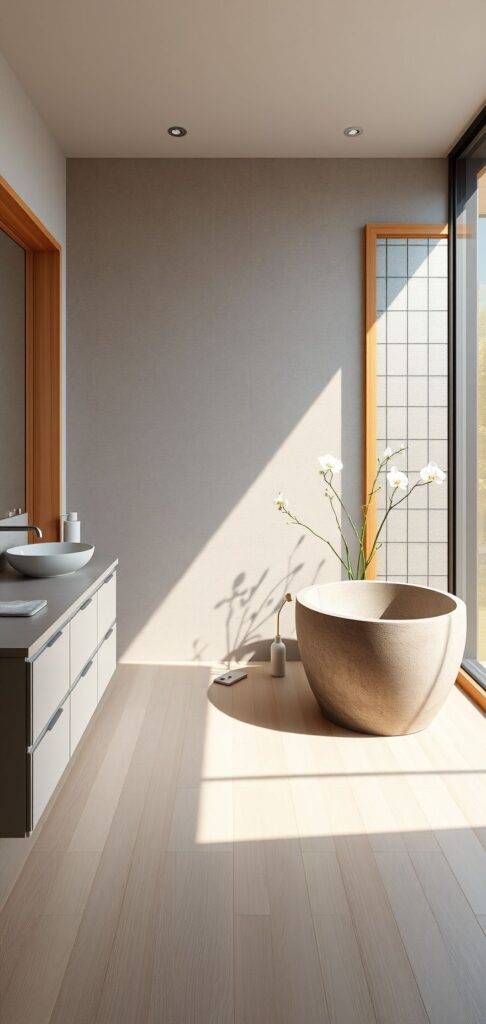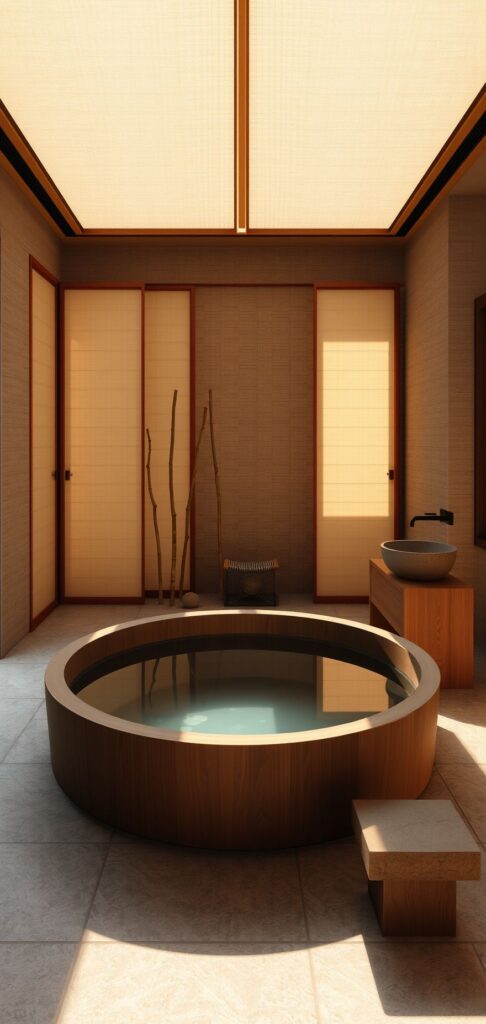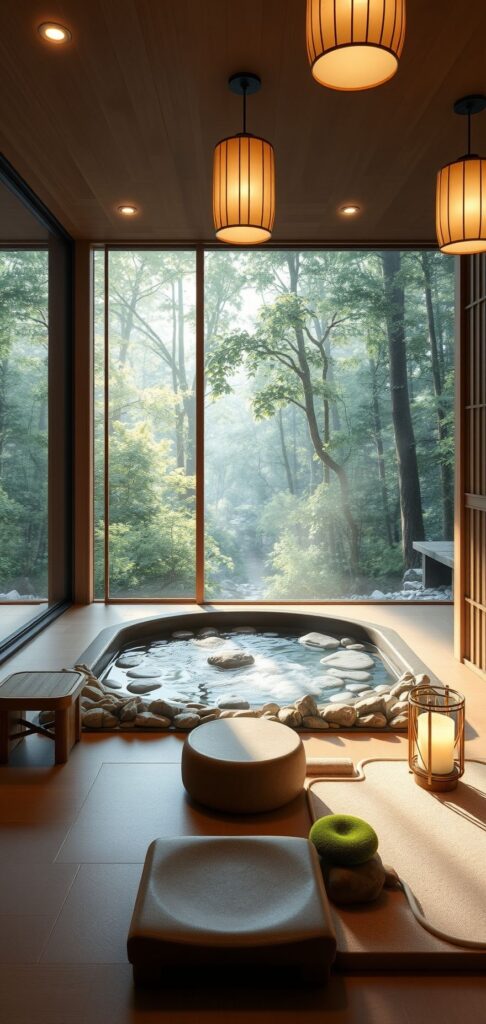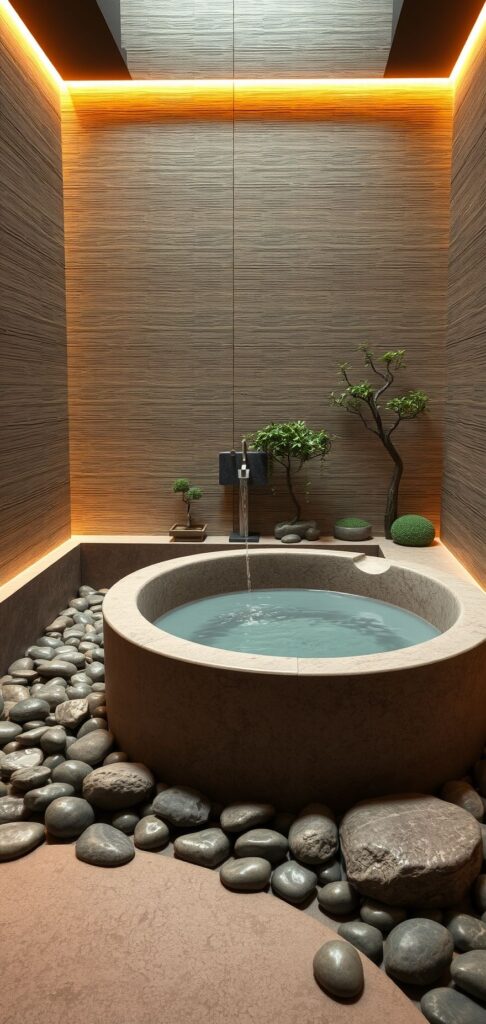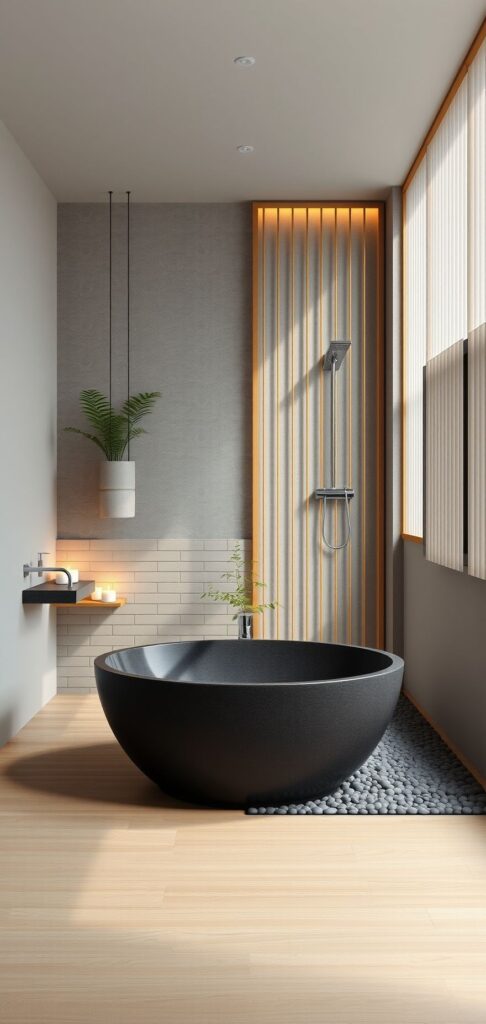Key Takeaways
- Creating a Japanese-themed bathroom can transport you to a serene, spa-like environment inspired by the traditional onsen.
- Embrace the beauty of natural materials like wood, stone, and bamboo to create a calming, earthy feel.
- Keep your space minimalist and clean to promote a sense of calm and mindfulness.
- Incorporate a soaking tub (ofuro) for deep relaxation and spiritual cleansing.
- Understand the cultural significance of Japanese baths, which serve as more than just functional spaces.
- Create a Zen atmosphere with elements like water features, minimalist lighting, and plants.
- Go beyond aesthetics by embracing the benefits of reduced stress and enhanced well-being.
- Use authentic Japanese fixtures to add depth and authenticity to your design.
Imagine stepping into a bathroom that feels like a serene Japanese onsen, where the days stresses melt away and you are enveloped in tranquility. Creating a Japanese-themed bathroom is more than just a design choice; its a journey to a peaceful, spa-like environment that can transform your daily routine. By blending traditional elements with modern design, you can craft a space that not only looks beautiful but also promotes relaxation and mindfulness.
To achieve this serene atmosphere, consider the key elements of a Japanese-themed bathroom: the use of natural materials, a minimalist and clean design, the inclusion of a soaking tub (ofuro), and a deep understanding of the cultural significance of Japanese baths. Each of these elements contributes to a Zen atmosphere that can be both visually appealing and deeply calming. Lets explore how you can bring the tranquility of a Japanese onsen into your home.
Embrace the Beauty of Natural Materials
Use Wood and Stone to Create a Connection to Nature
Incorporating natural elements like wood, stone, and bamboo can bring an earthy feel to your bathroom, enhancing the Zen atmosphere. Wood, especially types like cedar and cypress, not only adds warmth and texture but also has natural aromatic properties that can promote relaxation. Stone, such as granite or marble, can create a sense of stability and grounding. These materials are not only beautiful but also durable, making them ideal for a high-traffic area like a bathroom.
For example, a wooden vanity with a stone countertop can serve as a focal point, blending modern functionality with traditional aesthetics. Bamboo, often used in Japanese architecture, can be incorporated through bamboo blinds or a bamboo shower curtain, adding a touch of natural elegance.
Select Authentic Japanese Fixtures
Traditional Japanese fixtures can add authenticity and depth to your design. Consider using a bamboo shower curtain, which not only looks beautiful but also allows for natural ventilation. Shoji screens, made of translucent paper and wood, can create a soft, diffused light that enhances the Zen atmosphere. A tokonoma, a small alcove for displaying art or plants, can be a perfect spot to showcase your favorite Japanese art or a small bonsai tree.
These elements not only add visual interest but also connect your space to the rich cultural heritage of Japan. For instance, a shoji screen can be used to partition a larger bathroom, creating a private area for relaxation or meditation.
Keep It Minimalist and Clean
Simplify Your Space with Clean Lines and Minimal Decor
Maintaining a clutter-free environment is essential in a Japanese-themed bathroom. Minimalism in design promotes calm and mindfulness, allowing you to focus on the present moment. Start by choosing furniture and fixtures with clean, simple lines. A minimalist vanity with ample storage can help keep your space organized and tidy.
Consider the following tips:
- Declutter regularly: Remove any unnecessary items that do not serve a purpose.
- Choose multifunctional pieces: Opt for furniture that can serve multiple purposes, such as a vanity with built-in storage.
- Use neutral colors: Stick to a palette of whites, grays, and earth tones to create a serene and harmonious space.
Maintain a Sense of Simplicity and Balance
Balance is a key principle in Japanese design. Each element in your bathroom should serve a purpose and contribute to the overall harmony and tranquility. This can be achieved by carefully considering the placement and proportion of each item. For example, a large soaking tub (ofuro) can be balanced by a smaller, more delicate vanity or a minimalist wall-mounted sink.
To achieve balance, consider the following:
- Symmetry: Use symmetrical arrangements to create a sense of order and balance.
- Proportion: Ensure that the size and scale of each element are in harmony with the others.
- Negative space: Leave some areas of your bathroom open and uncluttered to create a sense of spaciousness and calm.
Incorporate a Soaking Tub (Ofuro)
What is an Ofuro and How is it Different from a Regular Bathtub?
An ofuro is a traditional Japanese soaking tub designed for full-body immersion. Unlike a regular bathtub, which is typically used for washing, an ofuro is primarily used for relaxation and spiritual cleansing. The deep, wide design allows you to sit with your shoulders submerged, promoting deep relaxation and stress relief.
The benefits of an ofuro include:
- Enhanced relaxation: The deep immersion in warm water can help reduce muscle tension and promote a sense of calm.
- Improved circulation: The warmth of the water can improve blood flow, which is beneficial for overall health.
- Spiritual cleansing: In Japanese culture, bathing is seen as a ritual for purifying the body and mind.
Create a Focal Point with an Ofuro
An ofuro can become the centerpiece of your Japanese-themed bathroom, creating a focal point that draws the eye and invites relaxation. Consider placing the ofuro in a location where it can be easily seen and accessed, such as near a window with a view of nature. This can enhance the experience and make it feel more like a natural retreat.
Placement ideas:
- Near a window: Position the ofuro near a window with a view of a garden or natural landscape.
- In a separate area: Create a dedicated soaking area with a small partition or screen to provide privacy.
- Center of the room: Place the ofuro in the center of the room to make it the focal point of the space.
Cultural Significance
Learn About the Traditions and Practices of Japanese Baths
The history and cultural significance of onsen in Japanese culture are deeply rooted in tradition. Onsen, or hot springs, have been used for centuries for their therapeutic and spiritual benefits. Bathing in a communal setting is seen as a way to connect with nature and others, promoting a sense of community and well-being.
Incorporating these practices into your home can involve:
- Communal bathing: Create a space where family members can bathe together, fostering a sense of togetherness.
- Spiritual cleansing: Use the ofuro for a ritualistic bath, focusing on mindfulness and relaxation.
Go Beyond Aesthetics: Embrace the Benefits
The true value of a Japanese-themed bathroom lies in its ability to promote relaxation and mindfulness. The cultural practices and design elements work together to create a deeply calming space. By incorporating elements like an ofuro, natural materials, and minimalist design, you can transform your bathroom into a sanctuary for daily relaxation.
The benefits of a Japanese-themed bathroom include:
- Reduced stress: The combination of natural elements and a minimalist design can help reduce stress and promote a sense of calm.
- Improved well-being: The therapeutic benefits of an ofuro and the use of natural materials can contribute to overall well-being.
- Enhanced mindfulness: The design and practices associated with Japanese baths can help you stay present and focused, enhancing your mindfulness.
Create a Zen Atmosphere
Use Elements Like Water Features and Minimalist Lighting
Incorporating water features, such as a small fountain or waterfall, can enhance the Zen atmosphere in your bathroom. The sound of flowing water can be incredibly soothing and can help mask outside noises, creating a more peaceful environment. Soft, ambient lighting can also play a crucial role in setting the mood. Consider using dimmable lights or LED strips to create a warm, inviting glow.
For example, a small wall-mounted fountain can be placed near the ofuro, creating a tranquil backdrop for your soaking experience. Soft, recessed lighting can be used to highlight key areas, such as the tokonoma or a piece of Japanese art.
Add Plants to Enhance the Tranquil Setting
Indoor plants can contribute to the Zen atmosphere and improve air quality in your bathroom. Choose plants that thrive in humid environments, such as ferns, peace lilies, or bamboo. These plants can add a touch of greenery and life to your space, making it feel more connected to nature.
Some of the best types of indoor plants for a Japanese-themed bathroom include:
- Ferns: Known for their lush, green fronds, ferns can add a touch of elegance to your space.
- Peace lilies: These plants are known for their ability to purify the air and thrive in low-light conditions.
- Bamboo: A symbol of strength and resilience in Japanese culture, bamboo can add a touch of natural beauty to your bathroom.
Practical Tips for a Japanese-Style Bathroom
Choosing the Best Materials and Fixtures
When selecting materials and fixtures for your Japanese-themed bathroom, consider the following factors:
- Durability: Choose materials that are durable and can withstand the humid environment of a bathroom.
- Aesthetics: Opt for materials that align with the minimalist and natural aesthetic of Japanese design.
- Functionality: Ensure that the fixtures you choose are functional and meet your daily needs.
Some top materials and fixtures for a Japanese-inspired design include:
- Wood: Cedar, cypress, and bamboo are excellent choices for their natural beauty and durability.
- Stone: Granite, marble, and slate can add a sense of stability and grounding.
- Bamboo fixtures: Bamboo shower curtains, blinds, and shelves can add a touch of authenticity and elegance.
Steps to Implement a Japanese-Style Bathroom
Transforming your existing bathroom into a Japanese-themed sanctuary can be a rewarding project. Heres a step-by-step guide to help you get started:
- Assess your space: Evaluate the size and layout of your bathroom to determine the best placement for key elements like the ofuro and fixtures.
- Choose natural materials: Select wood, stone, and bamboo for your vanity, countertop, and other surfaces.
- Incorporate traditional elements: Add a bamboo shower curtain, shoji screens, and a tokonoma to create an authentic Japanese feel.
- Simplify your decor: Declutter your space and choose minimal, functional furniture and fixtures.
- Add a water feature: Install a small fountain or waterfall to enhance the Zen atmosphere.
- Incorporate plants: Add indoor plants that thrive in humid environments to bring a touch of nature into your bathroom.
- Install soft lighting: Use dimmable lights or LED strips to create a warm, inviting glow.
- Create a focal point: Place the ofuro in a prominent location to make it the centerpiece of your bathroom.
By transforming your bathroom into a Japanese-themed sanctuary, you can create a peaceful retreat that promotes relaxation and mindfulness. Embracing the beauty of natural materials like wood, stone, and bamboo, and incorporating minimalistic design, can help you achieve a Zen atmosphere that feels deeply connected to nature. Traditional fixtures and elements, such as an ofuro and shoji screens, add authenticity and depth to your space.
Understanding and embracing the cultural significance of Japanese baths, including the communal and spiritual aspects of onsen, can elevate your bathroom beyond mere aesthetics to a true sanctuary for well-being. Adding water features, soft lighting, and indoor plants can enhance the tranquil atmosphere, making your bathroom a daily source of peace and relaxation.
By following practical steps to select and integrate these elements, you can transform your bathroom into a serene, Japanese-themed space that enhances your daily life. Whether you are seeking stress relief or simply a more harmonious living environment, the principles of Japanese design can guide you to a more tranquil and mindful existence.

